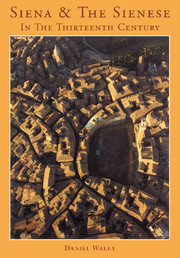Book contents
- Frontmatter
- Contents
- List of illustrations
- List of tables
- Preface
- Acknowledgements
- Glossary
- Abbreviations
- Chronology of principal political events and developments
- 1 Siena
- 1 Setting
- 2 People
- 3 Institutions
- 4 Oligarchy
- 5 Problems
- 6 Religion
- 7 Assumptions
- 8 Revenue
- 9 Expenditure
- 10 Continuity and change
- General Index
- Index of personal names
- Index of places
- Frontmatter
- Contents
- List of illustrations
- List of tables
- Preface
- Acknowledgements
- Glossary
- Abbreviations
- Chronology of principal political events and developments
- 1 Siena
- 1 Setting
- 2 People
- 3 Institutions
- 4 Oligarchy
- 5 Problems
- 6 Religion
- 7 Assumptions
- 8 Revenue
- 9 Expenditure
- 10 Continuity and change
- General Index
- Index of personal names
- Index of places
Summary
This book is concerned with the Sienese rather than their city, but as a preliminary something must be said about the setting within which they lived.
Medieval Siena was an extremely small urban zone in the wide expanse of a predominantly rural Tuscany. The appearance of the place was to strike a French traveller in 1580 as already one of great antiquity (‘son visage la tesmoine fort ancienne’). This visitor, Michel de Montaigne, saw Siena as an ‘uneven’ (inégal) town, ‘situated along a ridge where most of the streets are… Some of these continue onto the facing slopes of other hills’. The built-up area, rapidly growing in the middle decades of the thirteenth century, sprawled along two principal roads. The chief route from the north to Rome, the ‘Via Francigena’, bifurcated at the very centre of Siena, where the main road bore on, as the Via Cassia, towards Rome, and other routes led away to the south-west, towards Massa Marittima, Grosseto and the other towns of the Maremma. The city – Siena had a bishop and hence ranked as civitas – extended in fact along a series of ridges, from which housing had already begun to overflow onto the quite steep slopes and valleys which separated them. To walk from one end to the other of this site would have required no more than some fifteen minutes, unless the streets were exceptionally crowded, and to cross from east to west would have been the work of five minutes or less, despite the contours. Crowded into this urban microcosm were, around the middle of the thirteenth century, some 30,000 people, a number which was rapidly and continually increasing through immigration.
- Type
- Chapter
- Information
- Siena and the Sienese in the Thirteenth Century , pp. 1 - 15Publisher: Cambridge University PressPrint publication year: 1991



